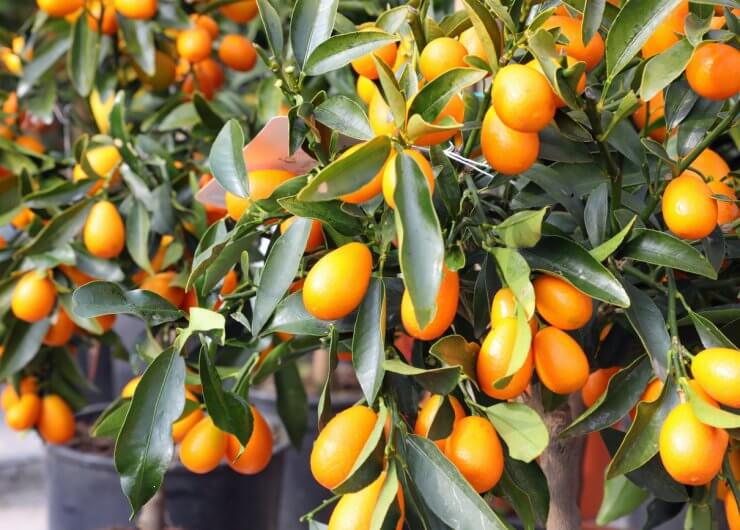
How to treat kumquat tree diseases
Kumquat tree diseases are caused by fungi and sometimes by insects; the damage they do to the tree can make the tree vulnerable to disease. The good news is that kumquat trees are highly resistant or even immune to citrus canker, which can affect other members of the citrus family.
Spot diseases on your kumquat trees sooner so you can treat plants before they are destroyed by disease and can successfully manage symptoms. Here is a three-step approach to keeping vigilant about the presence of kumquat plant diseases:
- Research the Risks. Find out about kumquat diseases that are prevalent in your geographic area. When possible, buy trees that have been grafted onto disease-resistant rootstock to avoid diseases in the first place.
- Examine Trees Daily. Check your kumquat trees every day to be sure no disease symptoms are present or emerging.
- Spot Diseases Early. Catch and treat disease quickly so your plants can recover and thrive.
An Ounce of Prevention
Make your own natural disease and pest control spray with benign materials. Mix one tablespoon of baking soda, 1/2 teaspoon of a mild dish detergent, and 2 1/2 tablespoons of olive oil in a gallon of water to make a solution that will repel all kinds of bugs, as well as act as a fungicide for blight and mildew on the kumquat plant leaves. Shake it well in your bottle before spraying, and repeat every week for it to be continuously effective.
We’re believers in avoiding using toxic materials in the garden whenever possible—they can hurt the plants, hurt the soil, damage the environment, and harm you.
Preventive measures to avoid kumquat plant diseases
Try some of these techniques for avoiding kumquat diseases in the first place:
Choose planting location carefully

Planting a kumquat tree
Make sure you plant your kumquat tree in a sunny spot; if you’re growing it in a container, make sure you can move it to the best spot to catch the minimum of eight hours of sunshine it craves.
Improve your soil composition
Before planting your kumquats, add a good amount of compost or organic matter to improve the soil. Extra nutrients and good aeration help grow stronger plants that will resist disease and infection.
Plant disease-resistant kumquat varieties
Many kumquat trees have been developed specifically to resist disease. Ask whether the tree you’re considering has been grafted onto disease-resistant rootstock.
Water your garden properly
Don’t underwater or overwater your kumquat trees. By keeping a regular watering schedule, you’ll keep your trees vibrant and healthy. Overwatering and watering directly on the trees—instead of the preferred watering method, directly onto the soil near but not on the trunk—leads to consistently wet conditions, which allows bacteria, fungi, and viruses to thrive and multiply.
Destroy infected plants
If your kumquat tree is infected beyond saving, throw it away. Don’t keep infected plants over the winter in your garden, and don’t throw them on your compost pile. Disease-ridden plants, even when dead, will spread the disease to other plants or even your soil.
When Homemade Remedies Aren’t Working

Healthy kumquat tree
You may find yourself in a situation where your homemade preventive measures are just not enough. At that point, you may need to turn to commercial products to protect your plant from further harm.
The most common infections in kumquat trees tend to be fungal. If you find you need to use a commercial fungicide, look for something that does the best job while providing the least risk to your trees and the biosystem. Some fungicides can be harmful to bees, which is bad news all around—we need to protect our pollinators. Of course, you also want to choose a product with the lowest risk of harm to humans, pets, and wildlife.
Some fungicides that have been rated as low-risk to bees and have a lower toxicity rating than other fungicides include those in the following list. We’re including the name of the fungicide along with some of the brand names containing it. This sampling list comes from the Iowa State University Extension Center.
Azoxystrobin: Armor Tech Zoxy-T, Azoxy 50 WDG, Compendium, Goliath, Headway, Heritage, Ortho Disease Control Pro
Cyazofamid: Segway
Fluidioxinil: Medallion, Nivales
Fluopicolide: Adorn Fungicide, Presidio Fungicide
Fluoxastrobin: Fame
Mancozeb: Bonide Mancozeb Flowable, Dithane, Lesco 4 Flowable, Penncozem
Mandestrobin: Pinpoint
Metconazole: Tourney Fungicide
Penthiopyrad: Velista
Polyoxin: Affirm
Potassium bicarbonate: Agricure, Bi-Carb Old Fashioned Fungicide, Green Cure, Milstop
Potassium phosphite: Appear
Sulfur: Bonide Citrus, Fruit, & Nut Orchard, Earth-Tone 3-in-1 Disease Control, Miracle-Gro Nature’s Care 3-in-1, Ortho Elementals 3-1in-1
Thiram: Defiant, Spotrete F Fungicide
Triticonazole: Trinity, Chipco Triton Flow, Triton 70WDG
This is by no means an exhaustive list, but it will help you focus your search for the appropriate treatment. Always read the label carefully before choosing to use a commercial product in your food garden. A good rule of thumb to begin your search is to look for products that include the word CAUTION regarding use; avoid products with the labels WARNING or DANGER. The fungicides in our list all come with use guidelines of CAUTION. Your risk tolerance may vary, but this is a good starting point.
In any case of plant disease, consult your local garden center or extension center for advice on the best disease control in your specific area.
If you spot other symptoms on your kumquat trees that are not mentioned here, contact your local extension center or garden center for a consult—and please let us know what you found.
Have you had problems with diseases attacking your kumquat trees? What types of problems do you regularly face with your kumquats? Please tell us how you treat and prevent diseases from destroying your kumquat trees.


 Previous
Previous


bienvenudouglas5@gmail.com